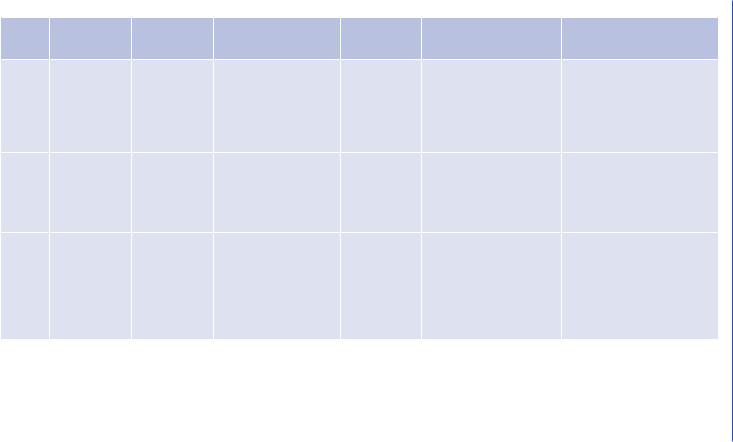
- •Preface
- •Contents
- •1.1 Introduction
- •1.2 Basic Principles
- •1.2.1 Formal Definition of Diffusion
- •1.2.2 Pulse Sequence Considerations
- •1.2.3 Diffusion Modelling in GI Cancer
- •1.2.4 Diffusion Biomarkers Quantification
- •1.3 Clinical Applications
- •1.3.1 Whole-Body Diffusion
- •References
- •2: Upper Gastrointestinal Tract
- •2.1 Introduction
- •2.2 Technical Details
- •2.2.1 Patient Preparation/Protocols
- •2.2.2 Image Acquisition
- •2.3 Artefact and Image Optimization
- •2.4 Clinical Applications
- •2.4.1 Upper GI Tract Malignancy
- •2.4.1.1 The Oesophagus
- •2.4.1.2 The Stomach
- •2.4.2 Role of DWI in Treatment Response
- •2.4.3 Other Upper GI Pathologies
- •2.4.3.1 Gastrointestinal Lymphoma
- •2.4.3.2 Stromal Tumours
- •2.4.3.3 Inflammation
- •References
- •3: Small Bowel
- •3.1 Introduction
- •3.2 Prerequisites
- •3.2.1 Patient Preparation
- •3.2.2 Imaging Protocol
- •3.2.3 DWI Analysis
- •3.3 Inflammatory Bowel Disease
- •3.3.1 Crohn’s Disease (CD)
- •3.4 Small Bowel Neoplasms
- •3.4.1 Adenocarcinoma
- •3.4.2 Lymphoma
- •3.4.3 Carcinoids
- •3.4.4 Gastrointestinal Stromal Tumours (GISTs)
- •3.5 Other Small Bowel Pathologies
- •3.5.1 Gluten-Sensitive Enteropathy
- •3.5.2 Vasculitis
- •3.5.3 Therapy-Induced Changes of the Small Bowel
- •3.6 Appendicitis
- •3.7 Summary
- •References
- •4: Large Bowel
- •4.1 Introduction
- •4.2 Technical Considerations
- •4.3 Detection of Polyps and Cancer
- •4.5 Assessment of Inflammatory Bowel Disease
- •4.5.1 Detection of Inflammatory Changes in the Colon
- •4.5.2 Assessment of Disease Activity
- •4.5.3 Evaluation of Response to Therapy
- •4.6 Future Applications and Perspectives
- •References
- •5: Rectum
- •5.1 Introduction
- •5.2 DWI for Primary Rectal Cancer Staging
- •5.2.1 DWI for Rectal Tumour Detection
- •5.2.2 DWI for Rectal Tumour Staging
- •5.2.3 DWI for Lymph Node Staging
- •5.3 DWI for Tumour Restaging After Chemoradiotherapy
- •5.3.1 DWI for Tumour Response Assessment
- •5.3.2 DWI for Mesorectal Fascia Assessment After CRT
- •5.3.3 DWI for Nodal Restaging
- •5.4 DWI for Follow-Up After Treatment
- •5.5 DWI as a Prognostic Marker
- •5.6 Pitfalls in Rectal DWI
- •References
- •6: Anal Canal
- •6.1 Introduction
- •6.2 Locoregional Staging of Anal Cancer (Baseline)
- •6.3 Locoregional Staging of Anal Cancer After Treatment
- •6.4 Perianal Fistula Disease Detection/Road Mapping
- •References

2 Upper Gastrointestinal Tract |
17 |
|
|
diffusion gradients including values of 500 and 800 s/mm2 or 600 and 1000 s/mm2 for the oesophagus, stomach and periampullary region. From our experience, and in agreement with published research, we found that a b-value of 800 s/mm2 provides a good balance between diffusion and image contrast.
Wang et al. demonstrated that most accurate tumour length measurements of the oesophagus were obtained using b = 600 s/mm2 [9]. Whereas Lee et al. found that in the periampullary region, lesions are more conspicuous at b-value of 800 s/mm2 demonstrating higher signal intensity, as bile appeared more frequently hyperintense on b = 500 s/mm2 than b = 800 s/mm2 [10]. The clinical application and interpretation of DWI in the upper gastrointestinal tract remain to be standardised to minimise disparity in the quantitative findings among different institutions.
2.3\ Artefact and Image Optimization
As discussed previously, MRI of the upper gastrointestinal tract is considered technically challenging due to motion artefact from the cardiac, respiratory and unpredictable physiological peristalsis. Flow artefact arising from adjacent aortic and pulmonary vasculature can diminish the accuracy of image interpretation. Movement artefact from the heart and lungs can be diminished by using automatic gated navigators.
Furthermore, due to the central location of the mediastinum in the body, the sensitivity of the receiver coil is reduced, and the signal-to-noise (SNR) ratio is subsequently diminished. An increase in the magnet strength (3 T in comparison to 1.5 T) will improve the SNR; however, a higher degree of susceptibility artefact will be encountered due to the larger surface area of air-fluid-tissue interface in the thoracic cavity [11].
Patients undergoing MRI to evaluate the upper GI tract may have an oesophageal stent in situ. Most oesophageal stents are ‘MRI compatible’ at 1.5 T; however, some are indicated conditional for use either due to MRI-related heating or generation of artefact or both. Image acquisition with a controlled whole-body averaged specific absorption rate (SAR) is generally recommended for conditional stents, although the manufacturer’s reference manual for magnetic resonance safety recommendations should be referred to for each implant or device on individual cases (Table 2.1).
2.4\ Clinical Applications
2.4.1\ Upper GI Tract Malignancy
2.4.1.1\ The Oesophagus
Oesophageal cancer remains a leading cause of cancer-related mortality, being the sixth most common cause of death worldwide accounting for 400,000 deaths in 2012 [12, 13]. The two most common histological subtypes are squamous cell carcinoma and adenocarcinoma. Whilst adenocarcinoma has become increasingly

Table 2.1 Staging with pretreatment ADC
|
|
Patient |
|
b-values |
|
|
|
Location of |
preparation |
|
(s/mm−2)— |
|
|
Study |
tumour |
prior to imaging |
ADC cut-off |
magnet strength |
Main outcome |
Additional comments |
Zhang |
n = 23 BT4 |
Overnight |
ADC < 1.84 × 10−3 mm2/s |
0, 1000–1.5 T |
Mean ADC value for BT4 |
Mean ADC value of the normal |
et al. |
gastric cancer, |
fasting, |
was a cut-off value to |
|
gastric cancer was |
stomach in healthy volunteers |
[4] |
n = 23 healthy |
800–1000 mL |
distinguish BT4 gastric |
|
1.12 ± 0.23 × 10−3 mm2/s; |
was 1.93 ± 0.22 × 10−3 mm2/s, |
|
volunteers |
water |
cancer from poorly |
|
significantly lower than |
which was significantly higher |
|
|
|
distended stomach wall |
|
nearby normal stomach wall |
than that of BT4 gastric cancer |
|
|
|
(specificity 95.7%, |
|
of 2.11 ± 0.21 × 10−3 mm2/s |
(p < 0.01) |
|
|
|
sensitivity 100%) |
|
(p < 0.001) |
|
Giganti |
Oesophageal or |
500 mL of |
Optimal cut-off for local |
0, 600–1.5 T |
MR has high specificity |
ADC values were different |
et al. |
Siewert I |
water and |
invasion: mean |
|
(92%) and accuracy (83%) |
between surgery-only and |
[15] |
n = 18 (nine |
Ferumoxsil |
ADC = 1.33 × 10−3 mm2/s |
|
for T staging and high |
chemo-/radiotherapy groups |
|
surgery and |
|
(p = 0.05) |
|
sensitivity (100%) with |
(1.90 mm2/s vs. |
|
nine CRT |
|
|
|
moderate accuracy (66%) |
1.30 × 103 mm2/s, respectively; |
|
before imaging) |
|
|
|
for N staging |
p = 0.005) |
Aoyagi |
Oesophageal |
6 h clear fluid |
1.5 × 10−3 mm2/s (92% |
0, 1000–1.5 T |
ADC values of cancer were |
ADC values of advanced-stage |
et al. |
SCC n = 123 |
only. N-Butyl |
sensitivity, 86% |
|
significantly lower than |
tumours were significantly |
[17] |
(n = 31 surgery, |
scopolamine |
specificity, 89% accuracy) |
|
normal oesophagus |
lower than early-stage tumours, |
|
n = 84 |
bromide IM |
|
|
(1.145 ± 0.321 × 10−3 mm2/s |
and a significant difference |
|
neoadjuvant |
|
|
|
vs. |
between Stages I and III |
|
therapy, n = 8 |
|
|
|
2.001 ± 0.385 × 10−3 mm2/s, |
(p < 0.05), I and IV (p < 0.05), |
|
not treated) |
|
|
|
respectively; p < 0.0001) |
II and III (p < 0.05) and II and |
|
|
|
|
|
|
IV (p < 0.05) was observed |
18
.al et Khouri-Al .M

Hou |
Oesophageal |
12-h fasting. |
– |
400, 600, |
Oesophageal SCC lengths |
Oesophageal SCC GTV upper |
et al. |
SCC n = 42 (all |
Supine |
|
800–1.5 T |
are most precise on DWI |
and lower margins were clearly |
[20] |
had radical |
|
|
|
when compared with CT or |
depicted; therefore, DWI fused |
|
surgery) |
|
|
|
MRI. |
with CT images can be used for |
|
|
|
|
|
Fused DWI/CT images were |
radiation treatment planning |
|
|
|
|
|
used to improve accuracy to |
systems |
|
|
|
|
|
delineate gross tumour |
|
|
|
|
|
|
volume (GTV) |
|
Avcu |
Gastric cancer |
- |
1.12 × 10−3 mm2/s to |
50, 400, |
The difference between ADC |
No statistical significance was |
et al. |
n = 70 and |
|
differentiate malignant |
800–1.5 T |
values of adenocarcinoma |
found between the subtypes of |
[23] |
healthy |
|
from benign gastric wall |
|
and lymphoma was |
gastric carcinoma |
|
individuals |
|
thickening (100% |
|
statistically significant, |
|
|
n = 30 |
|
sensitivity, 98.6% |
|
0.85 ± 0.16 × 10−3 mm2/s and |
|
|
|
|
specificity) |
|
1.09 ± 0.08 × 10−3 mm2/s, |
|
|
|
|
|
|
respectively (p < 0.05) |
|
Kantarci |
Gastric cancer |
- |
0.982 mm2/s |
50, 400, |
Mean ADC values of gastric |
Mean ADC values of gastric |
et al. |
n = 21 |
|
(87% sensitivity, |
800–1.5 T |
tumours were significantly |
tumours were significantly |
[24] |
|
|
100% specificity) |
|
lower than normal gastric |
lower than those found in the |
|
|
|
|
|
wall, 0.892 ± 0.23 SD mm2/s |
normal gastric wall (p < 0.05) |
|
|
|
|
|
and 1.453 ± 0.35 SD mm2/s, |
|
|
|
|
|
|
respectively |
|
Lee |
Biliary |
– |
– |
0, 500, |
DWI can help differentiate |
b = 800 s/mm2 is the optimal b |
et al. |
strictures in the |
|
|
800–1.5 T |
between malignant and |
value for periampullary regions. |
[28] |
periampullary |
|
|
|
benign periampullary |
DWI added to MRCP improves |
|
region n = 78 |
|
|
|
lesions. Most periampullary |
the diagnostic accuracy for |
|
|
|
|
|
carcinomas appear |
ampullary lesions |
|
|
|
|
|
hyperintense on high b value |
|
|
|
|
|
|
DWI |
|
Tract Gastrointestinal Upper 2
19

20 |
M. Al-Khouri et al. |
|
|
prevalent in Western countries, squamous cell carcinoma demonstrates the highest incidence worldwide [13].
Accurate initial tumour staging is mandatory for determining optimal patient management. A number of classification systems have been developed with the UICC TNM classification offering internationally agreed standards to categorise tumours and provide an indication for patient prognosis. The most recent version of the TNM Classification of Malignant Tumours (8th edition) for oesophageal cancer is shown in Table 2.2 [14].
Multimodality imaging plays an important role in the accurate staging of oesophageal tumours with MDCT, PET-CT and endoscopic ultrasound (EUS) widely recommended in accepted guidelines. MRI offers an alternative noninvasive cross-sectional modality which can accurately delineate anatomical detail of the oesophagus. A recent study by Giganti et al. [15] showed promising results in which MRI with added DWI had the highest specificity (92%) and accuracy (83%) for T staging when compared with other modalities [15]. In addition, DWI MR had the highest sensitivity (100%) in the detection of nodal disease with moderate accuracy (66%).
The optimal ADC cut-off values between normal oesophagus and cancer tissue can vary between studies, due to the lack of a standardised protocol. ADC cut-off values between 1.3 and 1.5 × 10−3 mm2/s have been described [15–17]. In the study by Aoyagi et al. [16], there was a good correlation between the ADC value and the clinical T and N stages in patients with oesophageal SCC tumours with the ADC value much lower in more advanced disease. In addition, there was also a negative correlation between ADC value, tumour diameter and SUV [16].
Angiogenesis remains an important element in determining tumour growth and risk of metastatic spread. Previous studies have found a negative correlation of ADC
Table 2.2 TNM staging of oesophageal cancer
Stage |
Level of involvement |
T—primary tumour |
|
TX |
Primary tumour cannot be assessed |
T0 |
No evidence of primary tumour |
Tis |
Carcinoma in situ/high-grade dysplasia |
T1a |
Tumour invades lamina propria or muscularis mucosae |
T1b |
Tumour invades submucosa |
T2 |
Tumour invades muscularis propria |
T3 |
Tumour invades adventitia |
T4a |
Tumour invades pleura, pericardium, azygous vein, diaphragm or peritoneum |
T4b |
Tumour invades other structures such as aorta, vertebrae or trachea |
N—Regional lymph nodes |
|
NX |
Regional lymph nodes cannot be assessed |
N0 |
No regional lymph node metastasis |
N1 |
Metastasis in one to two regional lymph nodes |
N2 |
Metastasis in three to six regional lymph nodes |
N3 |
Metastasis in seven or more regional lymph nodes |
M—Distant metastasis |
|
M1 |
No distant metastasis |
M0 |
Distant metastasis |
